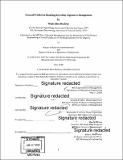Demand prediction modeling for utility vegetation management
Author(s)
McElroy, Wade Allen
DownloadFull printable version (11.97Mb)
Alternative title
Demand prediction modeling for utility VM
Other Contributors
Leaders for Global Operations Program.
Advisor
Georgia Perakis and Konstantin Turitsyn.
Terms of use
Metadata
Show full item recordAbstract
This thesis proposes a demand prediction model for utility vegetation management (VM) organizations. The primary uses of the model is to aid in the technology adoption process of Light Detection and Ranging (LiDAR) inspections, and overall system planning efforts. Utility asset management ensures vegetation clearance of electrical overhead powerlines to meet state and federal regulations, all in an effort to create the safest and most reliable electrical system for their customers. To meet compliance, the utility inspects and then prunes and/or removes trees within their entire service area on an annual basis. In recent years LiDAR technology has become more widely implemented in utilities to quickly and accurately inspect their service territory. VM programs encounter the dilemma of wanting to pursue LiDAR as a technology to improve their operations, but find it prudent, especially in the high risk and critical regulatory environment, to test the technology. The biggest problem during, and after, the testing is having a baseline of the expected number of tree units worked each year due to the intrinsic variability of tree growth. As such, double inspection and/or long pilot projects are conducted before there is full adoption of the technology. This thesis will address the prediction of circuit-level tree work forecasting through the development a model using statistical methods. The outcome of this model will be a reduced timeframe for complete adoption of LiDAR technology for utility vegetation programs. Additionally, the modeling effort provides the utility with insight into annual planning improvements. Lastly for later usage, the model will be a baseline for future individual tree growth models that include and leverage LiDAR data to provide a superior level of safety and reliability for utility customers.
Description
Thesis: M.B.A., Massachusetts Institute of Technology, Sloan School of Management, in conjunction with the Leaders for Global Operations Program at MIT, 2018. Thesis: S.M., Massachusetts Institute of Technology, Department of Mechanical Engineering, in conjunction with the Leaders for Global Operations Program at MIT, 2018. Cataloged from PDF version of thesis. Includes bibliographical references (pages 63-64).
Date issued
2018Department
Leaders for Global Operations Program at MIT; Massachusetts Institute of Technology. Department of Mechanical Engineering; Sloan School of ManagementPublisher
Massachusetts Institute of Technology
Keywords
Sloan School of Management., Mechanical Engineering., Leaders for Global Operations Program.